For our regular readers it’s no shock that we have more than the average share of predators lurking near our poultry and livestock pens.
In the six years we’ve been here though, we consider ourselves to have been relatively lucky, in that our losses have been kept very low considering the number of predators we see around the farm.
We’ve occasionally been criticized for not free-ranging our poultry full time, but more often than not, those that are the most critical seem to have a rather idyllic view of farming, and farm life.
Raising animals here is a constant challenge. The majority of the property is woodland, and predators abound. Although some of our predators, like Skunks, and Raccoons, predictably are active at night, most of our larger predators have no qualms about being active in the daytime.
Our first loss was Zilla, a lovely little Delaware hen, that was killed by a bobcat not six feet in front of me one afternoon, in broad daylight.
Then we lost three of Jenny’s little poults when an unknown intruder, presumed to be a raccoon, ripped off part of the wire on the enclosure in the middle of the night, and dragged the poults through the fence.
Frodo, our rooster, for a while, seemed to be a very effective predator magnet, attracting the attention of both Bobcats, and Coyotes.
It’s been quiet around here lately though. Almost too quiet. We hadn’t even seen any deer in months until a couple of days ago. We were actually getting used to not hearing a cacophony of squawks, and screeches, from paranoid poultry, because something furry was ambling along the hillside in the middle of the afternoon.
Then last Monday, I went to put up the turkey hens that range with our Tom, Jake Jr., for the night, and lock them in the pen. For some reason though the hens seemed spooked, and two of the hens took off running up the hill. It’s a very steep hill, with loose soils, and lots of slippery fallen live oak leaves, making the footing treacherous.
I tried until after dark to get the hens in the pen, but after finding myself face down in the dirt on the slope a few times, and realizing that all I was succeeding in doing was chasing them further up the hill, I reluctantly gave up. I knew all too well what the risks of leaving them out in the open would be, but I hoped they’d find a sheltered tall redwood, or oak, to roost in for the night, as we have no shortage of tall trees here, and I’d check on them first thing in the morning.
****note, some images below are graphic, and not to everyone’s taste, but this is part of the reality of farming here****
The next morning I could see from the kitchen window that one hen at least had found her way inside a new goat enclosure that we were building, where the door had been left partially open. However, I couldn’t see the other hen.
I thought maybe she was up behind the turkey pen, so I walked out to the poultry yard, and immediately noticed feathers on the ground. They were everywhere…stretching from one side of the poultry yard, to the other.
Then, as I turned around, I found the only evidence I needed to find. Blood.
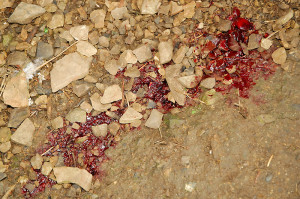
On the right, it’s clear this is where the hen was killed, as the surface of the rocks are covered in blood. She was then left, at least for a while, to bleed out
This blood streak was across at least an 18 inch stretch of soil, and the feathers were scattered all over the yard. There was now no question this hen was dead.
I expected to find a carcass, but my preliminary search yielded nothing. I thought the only predator here that would be capable of carrying off a whole 15-20lb turkey hen would be a Mountain Lion. Coyotes would likely have left even more of a mess. Having watched a Bobcat struggle to carry off a 7 lb pullet, I was having a difficult time envisioning a Bobcat as the culprit.
Living here I’ve become familiar with some of the corridors through the property that the wildlife use, especially the Bobcats, and Coyotes. One corridor is a very long drainage culvert that parallels the house, right at the valley bottom.
I walked along the bank above this culvert and didn’t see any sign of the hen. I saw no evidence that the carcass had been dragged, no feather trail, no blood trail. Nothing. She just seemed to have completely disappeared.
I found the remains of someone’s meal from earlier this winter, which looked to be a dis-articulated squirrel skeleton.
Perhaps the lunch of one of our resident red-tailed hawks, but still no sign of the turkey hen.
As I turned back toward the house I walked down the length of the culvert, and then realized I’d missed something. A few short tail feathers in the dirt were all I could see at first.
It took me a minute to realize that it was in fact the hen’s carcass, but it was buried. It was so well buried it didn’t seem there was much of the carcass left. Now I was really wondering who had dropped by for dinner.
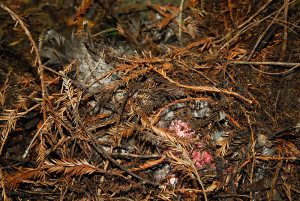
I’d finally found the carcass, buried with soil, and redwood litter, pulled down from the bank at the edge of the culvert
I considered picking up the carcass and examining it, to look for clues as to who may have taken her, but instead I chose to leave the carcass alone to avoid getting my scent on it. Instead, I went in the house and grabbed our game camera.
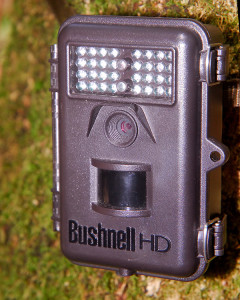
This camera can be set to take photographs (or video) whenever something crosses in front of it, day or night
I’ve used this camera before, mostly to see who was robbing out the garden at night.
This turkey hen was clearly someone’s intentionally buried prey cache. A number of animal species will bury the remains of their prey, to return to it later, including Foxes, Bobcats, and Mountain Lions. If the predator returned for the remains of the carcass, I was hoping it would help me identify the perpetrator.
The camera has an IR mode, and can record images at night when something crosses the camera’s field of view. I strapped it to a Bay Laurel tree, and hoped that whoever buried the carcass would return that night.
The next morning I found that a Bobcat had spent quite some time next to the carcass.
Not only did I catch the bobcat with the camera, but the carcass had clearly been disturbed, and much more of the hen was now visible.
As there were a lot more remains than I expected, I set the camera up for a second night assuming that whoever went to this much effort to cache its prey would certainly be back. Sure enough, as they say, ‘the cat came back‘…not once, but twice, that night.
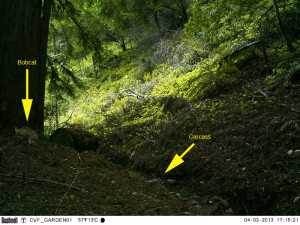
In this image the Bobcat is lurking near a redwood. Just on the other side of this tree, at 5:15 PM in the afternoon, our other turkeys are out free-ranging
Although the first images were clearly of a bobcat, the second cat that skulked into view in the early morning hours seemed quite large, and in part due to the rain, the images that morning were so poor that the characteristic markings weren’t visible on its coat.
I looked for other evidence, including scat, and footprints, and found neither. There is a very VERY thick layer of forest litter on the ground on this part of the property, most of it is Redwood debris, some Douglas Fir, and Bay Laurel leaves, and even I hardly leave footprints when walking in this area.
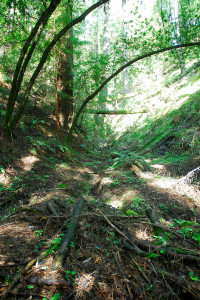
This is part of the woodland area on the property, near where we found the prey cache. Steep, shaded, with lots of leaf and wood litter on the forest floor
I did find an interesting tree. A young redwood, and its color was much lighter than the surrounding redwoods. As I got closer I could see why. The outer bark had been stripped off, and was scattered on the ground at the base of the tree.
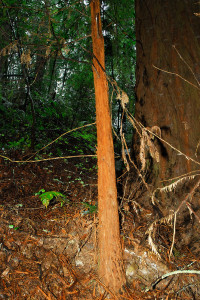
This young redwood appeared to have been used as a scratching post. Wild cats ‘claw-rake’ trees to mark their territory, and presumably sharpen their claws
Freshly peeled Redwood bark has a more orange hue, but darkens with age as it’s exposed to air and moisture. This tree looked like an over-sized scratching post, with the sort of damage your average house cat might do, just on a much larger scale.
I still wondered if we only had a Bobcat to worry about, as some of the damage extended more than 10 feet up over my head.
We do live in Mountain Lion territory, and the thought had already gone through my mind that we could potentially have a juvenile Mountain Lion in the area. One had been sighted a few weeks before, at the end of February, near the local high school, mid-morning, less than a half mile from the farm as the crow flies. All of our camera footage from last week, though, clearly suggested it really was just a Bobcat that took out our turkey hen.
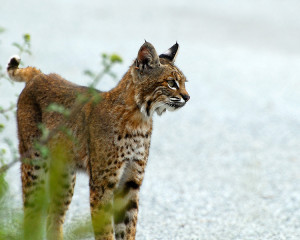
After seeing a Bobcat once struggle to drag off a 7-pound pullet, we were impressed that a Bobcat not only killed a mature turkey hen, but also carried her off, and buried her
I’ve worked with wildlife extensively in this area over the last two decades, and I’m not one to jump to conclusions, but the fact this predator had killed a mature female turkey hen, and seemingly carried her off, the thought of a Mountain Lion, at least a juvenile, had to cross my mind. Then once I found the damage to the tree, I really did wonder if perhaps the Bobcat might be a red-herring. Perhaps just an opportunist, scavenging on a fresh dead carcass, and the original assailant was possibly something larger.
Overall though, the evidence points squarely at a bobcat. Including this video. If you pay attention to the time stamp on the video, you’ll notice that ‘Bob’ was there for an entire hour from 1:15-2:15 AM.
We’ve seen many Bobcats in the years we’ve lived here, and he was simply in the right place, at the right time, the night our hens refused to cooperate and go into the pen at night. It’s possible ‘Bob’ was already lurking when I went to pen up the hens that night, and that’s why they were spooked. They’ve never run away from us, as usually their instincts compel them to roost somewhere secure for the night. It’s the first time we’ve never been able to pen everyone up at night. This hen’s loss does show the importance of securing our animals at night. On this farm, in this location, in the middle of a thriving wild-land habitat, there’s always someone hoping for an easy meal.
After Zilla was killed that Bobcat came around almost daily, for weeks on end. We even startled each other in the garden on more than one occasion. However, this bobcat not only killed a large turkey hen, but also succeeded in dining on her, so now that his hunt was successful, and his hunger satiated, I expect he’ll be back.
For now though the poultry, including the turkeys, are on complete lockdown. Knowing that this Bobcat has now finished the carcass, he’ll be looking for his next meal, and I’m determined to encourage this cat to look elsewhere for food. Thus far when I’ve seen Bobcats near the turkeys during the day, they simply walk straight past them, but for now it seems prudent to keep everyone secure.
This experience last week exactly highlights why we build secure enclosures for all of our animals, and why we don’t range any of our animals unsupervised.
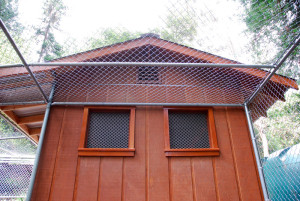
Predators on the farm are why we designed the goat barn to be a virtually impenetrable fortress, both inside, and out
Fencing our property isn’t practical due to the numerous elevation changes, which amount to a greater than 400 ft elevation change across the property. The tall trees, and slopes, make fences, even electric ones, relatively useless, as most of our predators can climb trees, or use the uphill slope to their advantage, and easily find their way over to the other side of the fence. That’s why when we built both goat enclosures, that they’re covered across the top.
We’ve been discussing the addition of livestock guardian dogs here, which we will need if we succeed in moving the farm to a more level location, but here the terrain is so variable, and our animals so spread out across the property, we’d need a small herd of dogs for them to be able to effectively cover the property.
I admit to being somewhat torn. I love seeing all the wildlife here, but I wouldn’t be honest if I didn’t admit that some days it is beyond frustrating trying to keep all of our animals happy, but most importantly, safe.
We don’t shoot, or trap predators on the farm (with the exception of gophers and voles). As we’ve said before, we’re the intruders, farming in the midst of ‘Bob’s’ habitat. He has every right to be here, and occasions such as this just remind that he’s there, waiting. So, for now, we’ll continue to manage our animals knowing that predators are very much part of the farm’s ecosystem, and last week’s loss is simply a reminder that even if we can’t see them, the predators are always there, lurking, and waiting for their next opportunity.

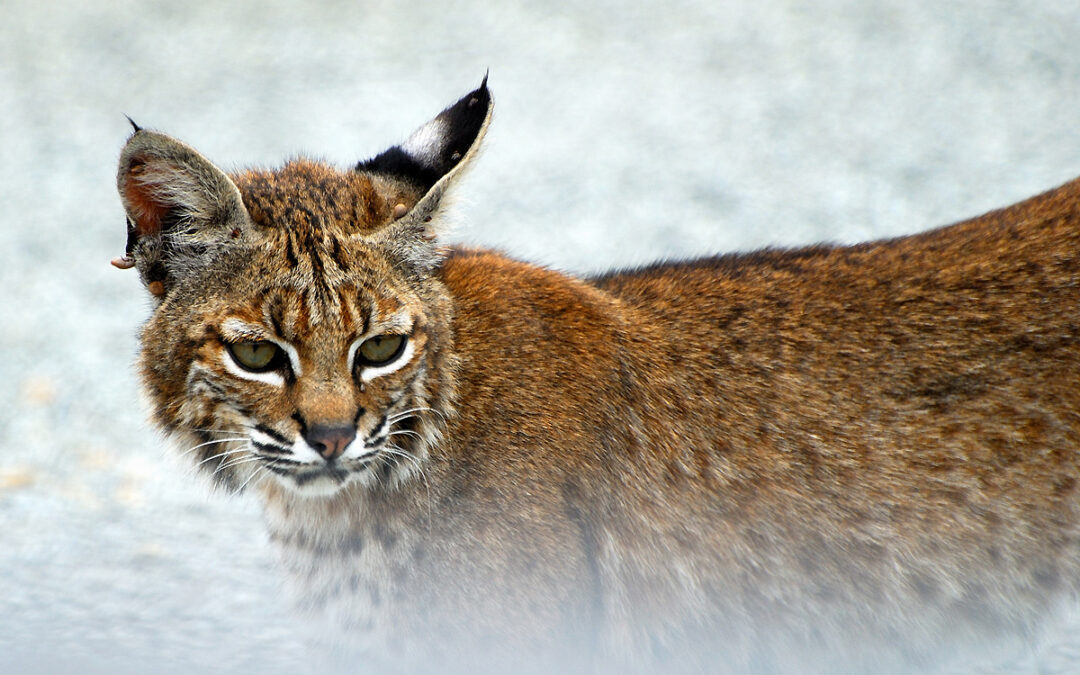
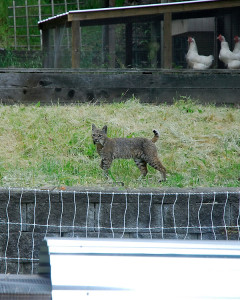


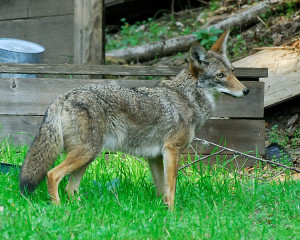
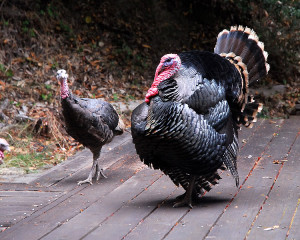
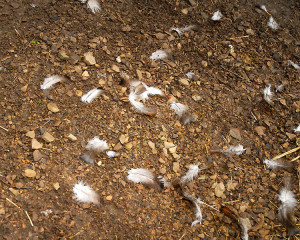

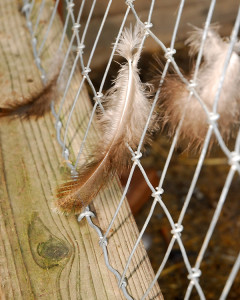


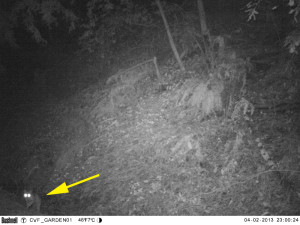
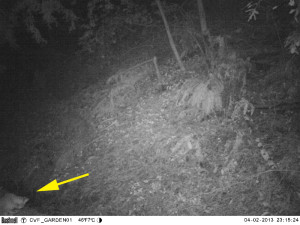
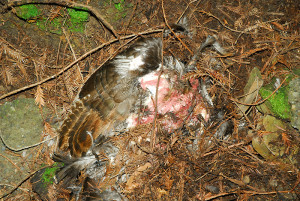
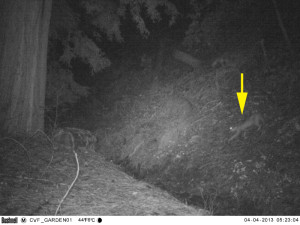
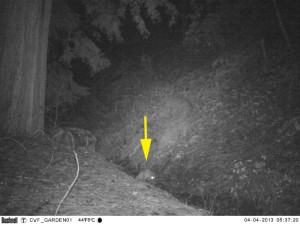
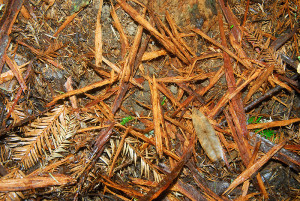
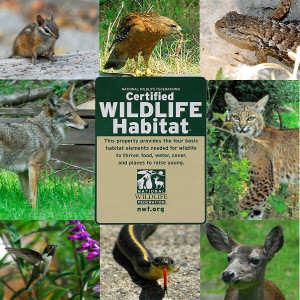
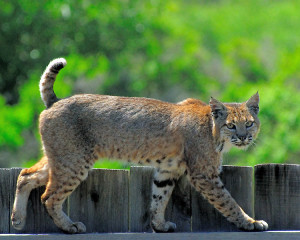







Well now, I Love the updates; reaching ten feet you say? This new scratching post evidence is veddy,veddy interesting indeed! I am not hoping for a lion mind you, but it would be kinda’ thrilling. I know you will be cautious!
Yep, at least twice as high as I am tall. I promise, I’m not hobbit proportioned 😉 I know it was Bobcat that did this, but there were a number of things that made me question that last week. I still can’t envision a Bobcat carrying a turkey hen, or managing to drag it 40 feet, and bury it, without losing as much as a feather off her carcass. I wish I could fit ‘Bob’ with a helmet cam! I thought I knew these cats, but I’m genuinely impressed. Sad we lost a hen, but very much impressed at Bob’s prowess.
Oh, that is so sad that you lost a big turkey. But what a great post. And great detective work. Loved the video of the bobcat feeding and cleaning itself afterwards. I too keep my hens under tight wraps. They can ” free-range” safely in their pen. I don’t want to risk their lives by letting them out where the night critters roam. A possum got one of my three chicks last summer, and it made me feel really guilty that I hadn’t been able to protect the little chicks better. Sadly, your turkey hen sealed her own fate by running away from you. I can understand being torn between the coolness of having coyotes and bobcats versus the reality that predators prey on farm animals.
It’s funny, I felt a little odd leaving the hen there, being more interested in who had taken her. I was willing to let ‘Bob’ have her, if I could convince myself it was only Bob I had to worry about. I do feel very bad though, that because of her determination not to roost that night, that she paid the price. I’ve learned though, that a turkey that is determined, is a force to be reckoned with!
Fascinating post! I am amazed at how at ease the bobcat was lounging by the car. One would think he was the family pet! I am sorry about the turkey! As you say, it is a lesson on the realities of farming. Even here, sometimes I am taken aback by nature in action. I once saw a hawk catch and eat a chipmunk, only a few feet in front of me. I am reminded of what my son said many years ago: “It’s the food chain, Mom!”
Our Bobcats here have no trouble reminding us who really belongs on the land here. They are very bold, and occasionally have even stood their ground against us. Fences are a minimal deterrent, and yelling and screaming at them is generally quite ineffective. They’re brazen, they’re bold, and they’re determined. Clearly, as Zilla proved, they’re not terribly impressed by the presence of humans, either. For the most part though, we have an understanding. If I don’t leave my hens out…Bob won’t eat them. 😉
What a story!! I am so impressed with the camera work and the great photos you got of the rascal. I would be devastated if anything ate my chickens. But they are perfect food for so many animals. My babies sleep inside. Sorry for the loss of yours – so sad!!
Although it’s very unfortunate we lost this hen, at least she had a good life while she was here. Unlike most commercially raised turkeys, she was able to forage outside, in the sunshine, hunting for bugs, weeds, and of course spoiled with all those garden leftovers too 🙂 I expect where you are, you probably have even more fierce predators to worry about!
A couple that I have gotten to know has a pasture-raised farm close to here. She has very large pens(surrounded my electrical fence) that she moves weekly. There is a lot of space for her chickens, turkeys and layers, but she still has to be careful of hawks. The birds have cover and they are quick enough to get there when the predators come. However, even with the electrical, there are periods when a ground based predator gets in overnight.
Like your sad story I have a friend in Vermont who once let her chickens out during the day but didn’t get back before night. When she returned all that was left in the field were feathers. She suspects fox that are constantly in the area.
It doesn’t sound easy.
We tried a portable electric poultry pen a couple of years ago…that’s when ‘Bob’ took Zilla. He didn’t notice the fence. Watching him jump over it, without getting zapped, while dragging a pullet in his jaws, was very enlightening! We use the fence around permanent pens if we’re having trouble with digging animals, like skunks, but we just don’t use it any more with the expectation that it will keep the poultry safe.
We do have foxes in the county here, but I’ve never seen one up here. I’m not sure the heavily forested vegetation suits them. I am grateful that’s one less predator we have to worry about 😉
Such wonderful captures of this beautiful cat even though it is hunting your farm animals…I love our critters although I wish someone would hunt the voles.
I don’t understand how voles seem to be immune from predators. It’s the same here too! I do understand that hunting a turkey is far more rewarding than hunting a vole, but I promise, we have more than a turkey’s-weight of voles to hunt around here! 😛
It’s small compensation that your turkey was killed to be eaten. Not like our domestic cats, who don’t always eat what they’ve killed.
There’s a part of me that feels that if this turkey had to go, at least it supported a creature as magnificent as this. I do also realize though, that by not taking the carcass away, I rewarded ‘Bob’. However, It was important for us to know if we might in fact have something larger predating our livestock, as it is a bit of a management game-changer. We do try to plan for Mountain Lions here, but thus far we’ve been fortunate, and not had to deal with them directly.
What a difficult balancing act. And lovely pictures!
It is a challenge. However, this property is also an amazing place to see an abundance of wildlife too! I’d just be happier if they’d stick to hunting the critters that keep nibbling on the fruits and vegetables in the garden 😉
I bought the same camera to watch night animals in our yard now that we have ducks. Thanks for this most interesting post with your fabulous photography, as always. Good luck to all the farm animals!